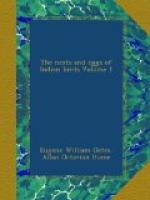The eggs of this species recall in many respects those of P. inornata, but the ground-colour is much more variable, and the markings are more blotchy and less intricate in shape. They are pretty regular ovals, and while some are very glossy others exhibit but little of this. The ground-colour is perhaps typically pale greenish blue, but in a great many specimens this is more or less obliterated by a reddish or pinkish tinge, as if the colour of the markings had run; in some the ground is a sort of reddish olive, in some pinky white. The markings are large blotches and spots, often forming zones or caps about the larger end, where they seem almost always to be most conspicuous, as they vary in colour from an intense burnt-sienna which is almost black, through a dingy maroon, and again to a dull, somewhat pale reddish brown; here and there individual eggs exhibit a hair-line or two, or a hieroglyphic-like mark, but these are the exceptions.
The eggs vary in length from 0.53 to 0.64 inch, and in breadth from 0.42 to 0.45; but the average of fourteen eggs is 0.58 by 0.44.
Very constantly smears or clouds of a paler shade than the blotches cover large portions of the surface between these. Occasionally all the markings are smeared and ill-defined, and in some eggs they are almost entirely wanting, and nothing but a scratch or two about the large end is to be seen.
Family LANIIDAE
Subfamily LANIINAE.
469. Lanius lahtora(Sykes). The Indian Grey Shrike.
Lamus lahtora (Sykes), Jerd. B. Ind. i,
p. 400.
Collyrio lahtora, Sykes, Hume, Rough Draft N. &
E. no. 256.
The Indian Grey Shrike lays from January to August, and occasionally up to October, but the majority of my eggs have been obtained during March or April.
It builds, generally, a very compact and heavy, deep, cup-shaped nest, which it places at heights of from 4 to 10 or 12 feet from the ground in a fork, towards the centre of some densely growing thorny bush or moderate-sized tree, the various carounders, capers, plums, and acacias being those most commonly selected.
As a rule it builds a new nest every year, but it not unfrequently only repairs one that has served it in the previous season, and even at times takes possession of those of other species.
The nest is composed of very various materials, so much so that it is difficult to generalize in regard to them. I have found them built entirely of grass-roots, with much sheep’s wool, lined with hair and feathers, or solidly woven of silky vegetable fibre, mostly that of the putsun (Hibiscus cannabinus), in which were incorporated little pieces of rag and strips of the bark of the wild plum (Zizyphus jujuba); but I think that most commonly thorny twigs, coarse grass, and grass-roots form the body of the nest, while the cavity is lined with feathers, hair, soft grass, and the like.




